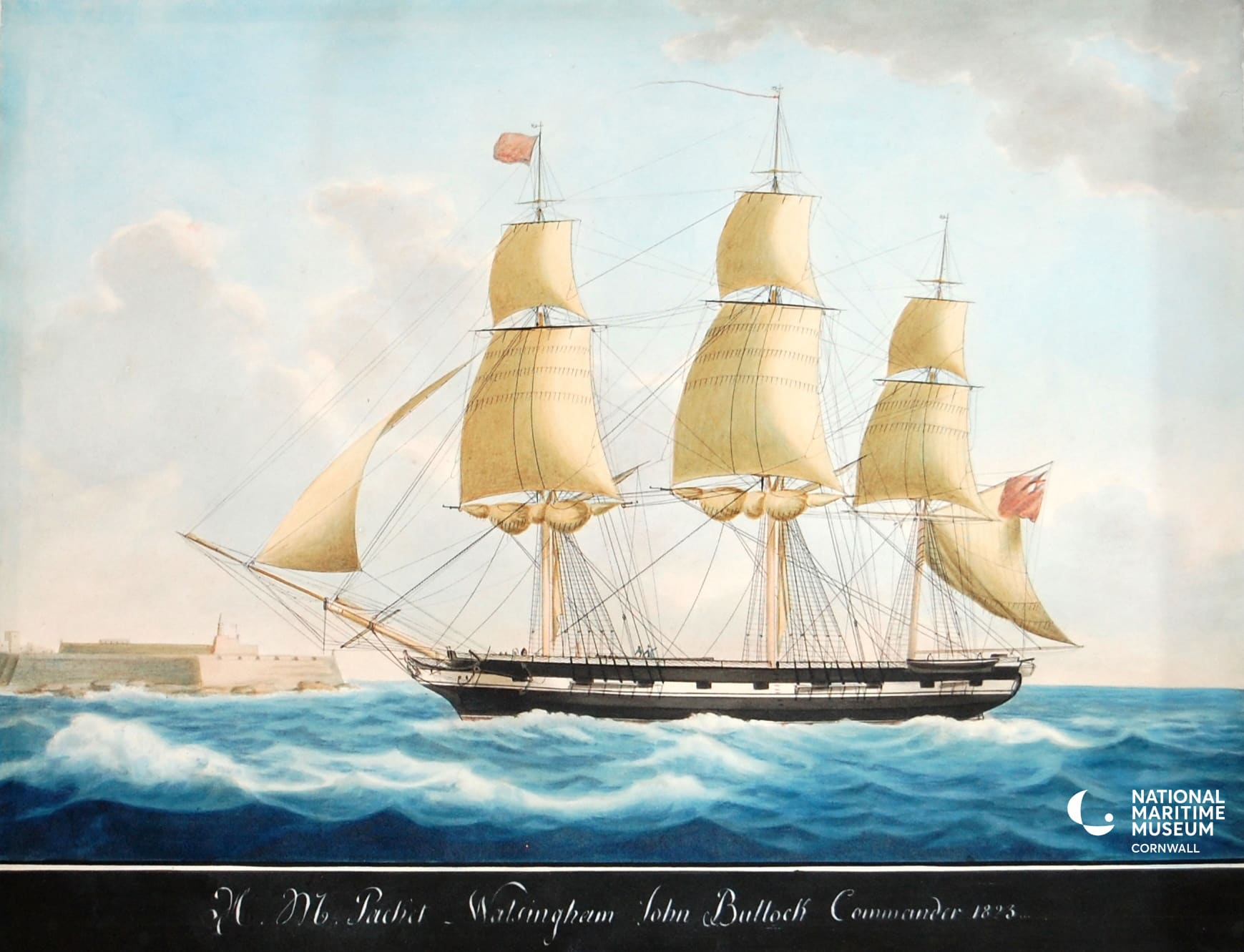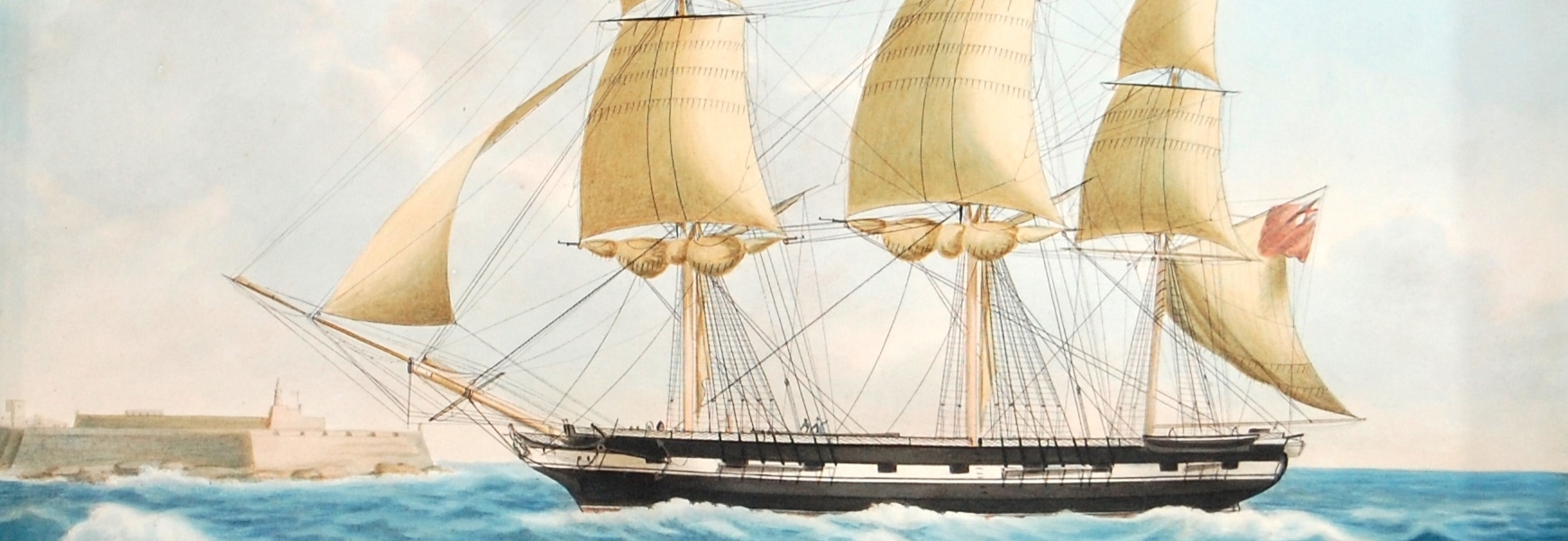By Ron Hawkins
Over 20 years ago there was considerable excitement when the Museum received six Packet Ship portraits by the noted pierhead painter Nicholas Cammillieri (1773? – 1860). Ron Hawkins, a Bartlett Library volunteer, undertook research on the paintings and the artist and produced a series of articles for the Library’s online journal Maritime Views. This month’s Bartlett Blog by Ron Hawkins highlights the portraits once again.
The Portraits at National Maritime Museum Cornwall
The Museum is fortunate in owning six Packet Ship portraits which represents one of the larger collections in any museum. They were all painted in Malta between 1817 and 1823 and illustrate the operation of the Falmouth Packet Service through the Post Office private contract scheme.
The Falmouth Packet Service
The Post Office Packet Service was a branch of the Royal Mail established to carry international mails and government dispatches and sea links were an important part of the service.
Falmouth, established as a new town in 1661, with its deep estuary, good shelter and anchorage and located at the south-western approaches to the British mainland, became an important Packet station in 1688. Initially serving Spain via Corunna and then Portugal via Lisbon, by 1705 there was also a regular service to the West Indies and the Americas.
Until 1823 The Falmouth Packet Service was under the control and management of the Post Office when it was taken over by the Admiralty. Until then it was a civilian service using hired sailing vessels each with their own commanders and crews. At its height the service employed over 1,200 seamen and was a dominant entity in the town. After over 150 years in service the Falmouth Packet Station finally closed in 1851.
The Portraits
Cammillieri could have had the opportunity to paint at least fifteen Post Office Packets. The Museum’s Cammillieri Collection represents six of His Majesty’s Packets based in Falmouth and is unique in its coherence of subject matter.
The vessels are HMPs Swiftsure, Walsingham, Francis Feeling, Fox, Lady Mary Pelham and Countess of Chichester. They were all built variously between 1795 and 1816 with three being built in Cornwall in Fowey and Falmouth, two in London and one in New York.
Although the Maltese spelling of the family name is the shorter form of Camillieri, Nicolas always signed his paintings with the longer French form Cammillieri. The full style of his signature on the paintings follows a number of variations. It can take the form of either Nicholas or Nicolas Cammillieri, the initials N or NS Cammillieri, the abbreviation N Cm or the corporate sounding Cammillieri of Malta.

His Majesty’s Packet Walsingham, Nicholas Cammillieri (1773? – 1830), copyright National Maritime Museum Cornwall
The Artist
While the death of Nicholas Cammillieri in 1860 is well documented the date of his birth has not yet been firmly established. Cammillieri’s death is recorded at Vittoriosa, Malta on 18th February 1860 and his age is given as 87. On this evidence he would have been born around 1773.
Cammillieri’s Maltese nationality is confirmed by a number of sources but there are some suggestions that the family were originally of Italian extraction. There is also evidence of his support for the cause of Italian independence whether from family or political sympathy. It may have been because of such sympathy that he left Malta as a young man to further his artistic talent.
Although he spent his successful career as a prolific ship portraitist little is known about his artistic training. There were family claims that he had studied painting in Paris but no evidence has come to light to confirm such a period of study. His earliest known painting, showing a French ship in Marseilles harbour is dated 1805 and it is known that he lived and worked in Marseilles for the first part of his career. Marseilles was home to the Roux family, a dynasty of painters who were influential in establishing a new school of ship portraiture known as pierhead paintings and there is evidence to show that Cammillieri was well acquainted with the family. Masters and owners of ships were eager to have portraits of their vessels to display in their homes and offices and artists were able to exploit the growing demand.
By 1811 Cammillieri was well established in Marseille as earning ‘a living through his ingeniosity in painting seascapes and ships’. His work was held in high regard and his reputation spread amongst sea captains so that when he returned to Malta around 1817 he was able to maintain his career in full from that base. His paintings of the Swiftsure and Countess of Chichester are amongst the earliest of the Maltese paintings.
He became a well established figure in Malta, father of a large family with a successful career. The length of his career tells of business acumen as well as formidable stamina. He had gained prominence and respect in two communities and continued painting until the end of his life. His last known painting is dated 1858.
Read more about the Cammillieri Packet Portraits
For a more detailed look at all six of the portraits and more about Nicholas Cammillieri see the article by Ron Hawkins on the Cammillieri Packet Portraits online at the NMMC’s Maritime Views.
The Bartlett Blog
The Bartlett Blog is written and produced by the volunteers who staff The Bartlett Maritime Research Centre and Library of National Maritime Museum Cornwall. The Cammillieri Packet Portraits was written by Ron Hawkins.
The Bartlett Library holds a Collection of over 20,000 volumes and offers access to one of the finest collections of maritime reference books, periodicals and archival material. The Bartlett Blog reflects the diversity of material available in The Bartlett Library.



